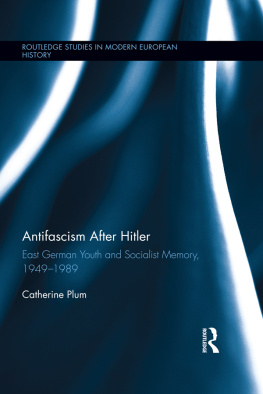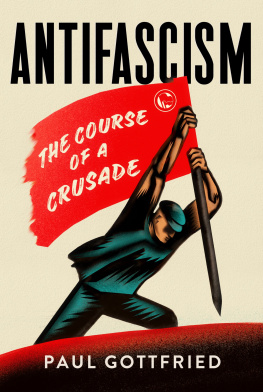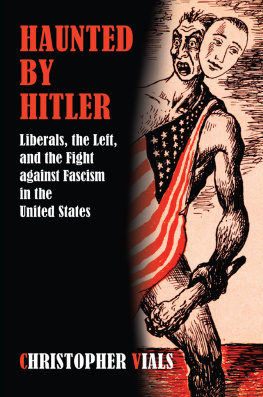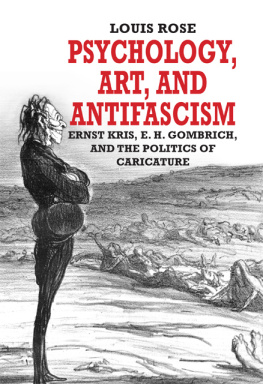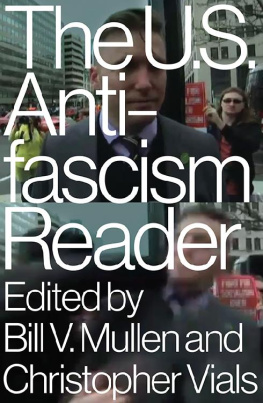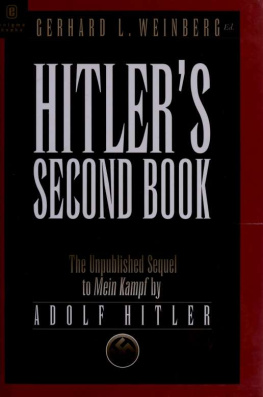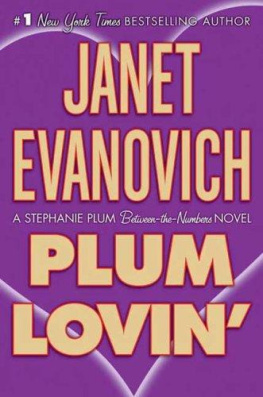Plum - Antifascism After Hitler
Here you can read online Plum - Antifascism After Hitler full text of the book (entire story) in english for free. Download pdf and epub, get meaning, cover and reviews about this ebook. City: Taylor and Francis, publisher: Taylor & Francis (CAM), genre: Home and family. Description of the work, (preface) as well as reviews are available. Best literature library LitArk.com created for fans of good reading and offers a wide selection of genres:
Romance novel
Science fiction
Adventure
Detective
Science
History
Home and family
Prose
Art
Politics
Computer
Non-fiction
Religion
Business
Children
Humor
Choose a favorite category and find really read worthwhile books. Enjoy immersion in the world of imagination, feel the emotions of the characters or learn something new for yourself, make an fascinating discovery.
- Book:Antifascism After Hitler
- Author:
- Publisher:Taylor & Francis (CAM)
- Genre:
- City:Taylor and Francis
- Rating:3 / 5
- Favourites:Add to favourites
- Your mark:
- 60
- 1
- 2
- 3
- 4
- 5
Antifascism After Hitler: summary, description and annotation
We offer to read an annotation, description, summary or preface (depends on what the author of the book "Antifascism After Hitler" wrote himself). If you haven't found the necessary information about the book — write in the comments, we will try to find it.
Plum: author's other books
Who wrote Antifascism After Hitler? Find out the surname, the name of the author of the book and a list of all author's works by series.
Antifascism After Hitler — read online for free the complete book (whole text) full work
Below is the text of the book, divided by pages. System saving the place of the last page read, allows you to conveniently read the book "Antifascism After Hitler" online for free, without having to search again every time where you left off. Put a bookmark, and you can go to the page where you finished reading at any time.
Font size:
Interval:
Bookmark:
The Youth Memory Landscape
In the summer of 1961, the cruise ship Thlmann Pioneer set sail, introducing East German children to foreign lands. Young Pioneers all over the GDR who read the magazine ABC Zeitung ( ABC Newspaper ) may have been surprised to learn that their youth organization possessed its very own cruise ship, purchased from the proceeds of recycling drives and childrens allowance money. Unsurprisingly, the cruise ship bore the name of Ernst Thlmann, the most famous German communist who fought against fascism. Thlmann, also known as Teddy, was not a stranger to them. Young readers knew that Thl-mann had died under Nazi captivity for his socialist beliefs and resistance efforts. On more than one occasion, articles in the ABC Zeitung emphasize that numerous ships, schools, factories and streets at home and abroad share the name of Ernst Thlmann, the patron of their own youth organization.
The magazine commissioned readers to send a postcard to the editors of the ABC Zeitung by the anniversary of Thlmanns death on 16 August, recording where they had seen Thlmanns name over the summer. In honor of Thlmanns birthday in April 1962, the ABC Zeitung published some of the replies they received from readers. A student named Katrin from Frstenwalde writes that when she became a Young Pioneer, her mother gave her a book on Ernst Thlmann as a present. One ABC reader, Eveline, notes that while she was on vacation in Auerbach, she found a street sign bearing the name Ernst Thlmann. In a third example Robert from Berlin writes,
I have often heard of the name Ernst Thlmann. In 1936 the international brigades fought against the fascist Franco in Spain. A German battalion carried the name Ernst Thlmann. I also know a song about that, The skies over Spain open up to the stars. There is a Thlmann brigade at the factory where my grandmother works. At home we have a Thlmann picture ( Thlmannbild ).
These examples suggest that students did in fact learn about Ernst Thlmann and other antifascist figures in a variety of settings, on city streets and factory signs, in their music classes at school, and in books and pictures found in their own homes in some cases. The regime called on administrators and youth mentors in a variety of settings to pass on to students a sense of ownership and commitment to antifascist traditions and the official narrative of antifascism.
A thorough study of antifascist education and commemoration requires a comprehensive analysis of students experiences at school and on fieldtrips to historical sites, within the youth group setting and while engaged in extracurricular activities, in their hometowns and at summer camp. The success of antifascist education and youth commemoration was dependent on the variety of institutions, sites and rituals, both concrete and metaphorical, which formed the youth memory landscape. This chapter introduces the memory sites and explores each sites specific role and history in the broader campaign to promote antifascism within the school-age population. The Zusammenarbeit , or cooperation, between institutions and their staff was essential for the comprehensive and coordinated approach to antifascism that the regime demanded increasingly over time.
During the period of Soviet occupation and the early years of the GDR, the school system in Eastern Germany underwent a number of changes in terms of personnel, organization and educational philosophy. In the fall of 1945, some of the first new administrators in education were social democratic pedagogues and communists in the field of education who had immigrated to Moscow during the Nazi period. Many of the new teachers who stayed in the teaching profession later rose to become assistant principals and principals in later decades, positions responsible for coordinating antifascist education and commemoration. After the founding of the GDR in 1949 and the reorganization of provinces that followed in 1951 and 1952, the Ministry of Education in Berlin presided over fifteen departments of education at the provincial level ( Bezirk ), which in turn controlled individual districts ( Kreise ), each with its own school board. Decisions made at one level of this hierarchical system filtered down to the lower levels of administration, ending with each school. Following a series of short-lived administrations, Margot Honecker accepted the position of minister of education in 1963, and she held this position until 1989, providing a long period of stable leadership for the further development of socialist, antifascist schools.
The transformation of traditional elementary and secondary schools ( Grundschulen , Realschulen , and Gymnasien ) into ten-year polytechnical schools ( Polytechnische Oberschulen , or POSes) and university-preparatory schools ( Erweiterte Oberschulen , or EOSes) in the late 1950s and early 1960s was designed to further develop the technical and intellectual leadership skills of future socialist citizens.
From the late 1940s onward schools in Eastern Germany pursued their mission to mold children and youth into antifascist supporters and activists. School administrators viewed the socialist school setting as an environment with ideological tenets in sharp contrast to those instilled under National Socialism on a number of different levels. Unlike their Nazi predecessors, the ideal antifascist school would promote the advancement of students based in part on their class backgrounds, gender equality and evidence of the development of students socialist personalities, as seen in their class behavior and performance in civics class ( Staatsbrgerkunde ). Antifascist education began with songs that first graders sang and with second-grade social studies textbooks. The education ministry required that schools promote antifascist education and commemoration using a variety of different methods, with expectations changing gradually over time as different generations entered and progressed through the school system. To assess the full range and impact of antifascist education, it is important to explore multiple facets of school life, including a wide variety of pedagogical materials, classroom activities, all-school assemblies and research projects. We should first question what basic tools teachers had at their disposal to teach students about the recent past, even as some historical documents remained locked in poison cabinets.
Curriculum plans ( Lehrplne ) and textbooks outlined and defined the program of study for each subject in socialist schools. Before the end of 1945, the recently founded publishing firm Volk und Wissen had printed over four The 1950s saw frequent curriculum and textbook revisions, and in subsequent decades these materials continued to be revised on a regular basis by the DPZ and later the Academy of Pedagogical Research (Akademie der Pdagogischen Wissenschaft, or APW), the institute that replaced the DPZ in 1970. In a 1963 publication, three employees of the DPZ explain the importance of textbooks in the socialist school:
The textbooks help the teacher and the youth learn to be educated, committed fighters for the truth, peace [and] the socialist Fatherland, in the spirit of socialist internationalism and of friendship for all peoples. East German education will become an example and a national model for the democratic renewal of the West German school.
With this statement, the DPZ defended itself against West German attacks decrying the politicized content of the East German curriculum. The institute reacted to such criticism by arguing that West German schoolbooks embraced colonialist pursuits and militarism in a fascist manner. History and civics textbooks, in particular, served as political ammunition in the ideological warfare that raged between East and West Germany.
Font size:
Interval:
Bookmark:
Similar books «Antifascism After Hitler»
Look at similar books to Antifascism After Hitler. We have selected literature similar in name and meaning in the hope of providing readers with more options to find new, interesting, not yet read works.
Discussion, reviews of the book Antifascism After Hitler and just readers' own opinions. Leave your comments, write what you think about the work, its meaning or the main characters. Specify what exactly you liked and what you didn't like, and why you think so.

